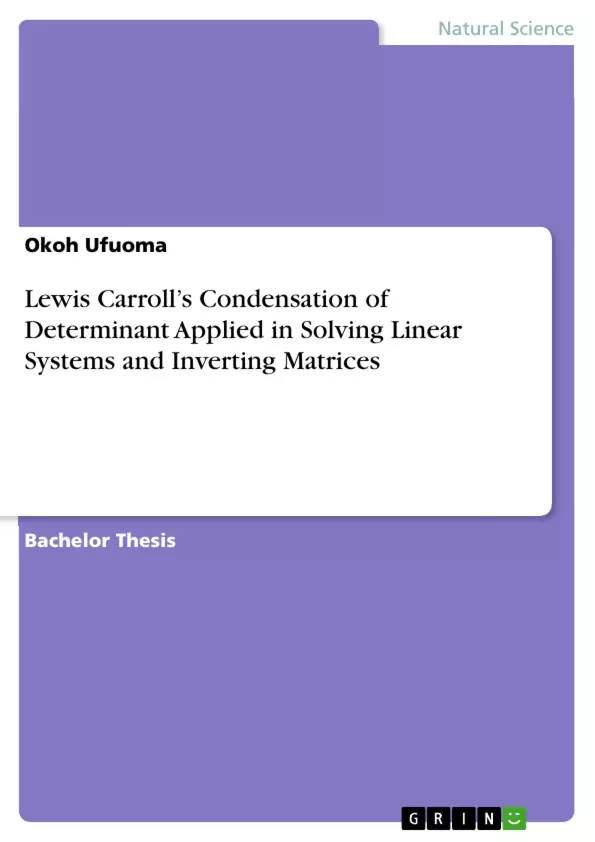The chief purpose of writing this little book is to expose the reader to new applications of Dodgson’s condensation for determinant evaluation, namely the solving of large linear systems and the computation of the inverses of large matrices. In the course of discussing these applications, the Author attempts to make the work of “the great Oxford lecturer”, Rev. Charles Lutwidge Dodgson (1832–1898), accessible to the mathematician of today who might not be able either to read his 1866 paper delivered to the Royal Society of London, or, having read it, to master it and grasp the whole scheme of the paper.
Inhaltsverzeichnis (Table of Contents)
- Preface
- 1 Introduction
- Linear Systems
- Matrices
- Determinant Notation
- Inverses of Matrices
- 2 Dodgson's Condensation
- Dodgson's Life
- Condensation Method
- Present Interest in Dodgson's condensation
- 3 Division by Zero Problem
- Recommencing the Operation Method
- Limit Method
- 4 Solving Linear Systems
- Cramer's Rule
- A New Method using Dodgson's condensation
- 5 Inverses of Matrices
- Matrix Inversion by Minors
- Matrix Inversion by Gauss-Jordan method
- A New Method of Matrix Inversion
- Proof of the Validity of the New Approach
- Derivation for 2 × 2 Matrix
- Derivation for 3 × 3 Matrix
- Derivation for 4 × 4 Matrix
Zielsetzung und Themenschwerpunkte (Objectives and Key Themes)
This work aims to provide a comprehensive analysis of Lewis Carroll's Condensation of Determinant and its applications in solving linear systems and inverting matrices. The study focuses on the historical context of the method, its mathematical principles, and its contemporary relevance. The work explores the method's application in solving linear systems and matrix inversion, highlighting its advantages and limitations compared to conventional methods.
- Lewis Carroll's Condensation of Determinant
- Solving Linear Systems
- Inverting Matrices
- Historical Context and Mathematical Principles
- Comparison with Conventional Methods
Zusammenfassung der Kapitel (Chapter Summaries)
The first chapter introduces the fundamental concepts of linear systems, matrices, determinant notation, and matrix inverses. This chapter serves as a foundational basis for understanding the subsequent analysis of Lewis Carroll's Condensation of Determinant. Chapter 2 delves into the historical context of Dodgson's Condensation, exploring his life and the method's development. It also examines the contemporary interest in this method, highlighting its potential applications in modern mathematics. Chapter 3 addresses the challenges posed by division by zero in the application of Dodgson's Condensation, presenting two methods for resolving this issue: Recommencing the Operation Method and the Limit Method. Chapter 4 explores the application of Dodgson's Condensation in solving linear systems, contrasting it with Cramer's Rule and presenting a novel method based on this condensation technique. Finally, Chapter 5 delves into the utilization of Dodgson's Condensation in matrix inversion, comparing it to established methods such as Matrix Inversion by Minors and Gauss-Jordan elimination. It introduces a novel method for matrix inversion and provides a rigorous mathematical proof of its validity for matrices of different dimensions.
Schlüsselwörter (Keywords)
The main keywords and focus topics of this work include Lewis Carroll's Condensation of Determinant, Dodgson's Condensation, linear systems, matrix inversion, Cramer's Rule, Gauss-Jordan elimination, division by zero, and matrix minors. This work explores the historical context, mathematical principles, and contemporary applications of Dodgson's Condensation, highlighting its strengths and weaknesses in comparison to traditional methods.
- Quote paper
- Okoh Ufuoma (Author), 2020, Lewis Carroll’s Condensation of Determinant Applied in Solving Linear Systems and Inverting Matrices, Munich, GRIN Verlag, https://www.grin.com/document/592161



